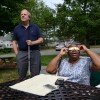I bought a tall PSL recently — my first ever. In case you don’t know Starbucks lingo, that’s a small Pumpkin Spice Latte. I thought it might distract me from what some are describing as the end-of-the-world syndrome: the bundling of emotional stresses, from wildfires to the delta variant, to hurricanes and political scandals.
This first purchase makes me late to the party that Starbucks started 18 years ago, when the global coffee chain was looking for a new flavor to mark the onset of fall. They taste-tested several flavors before settling on pumpkin spice, and then set about trying to capture it into a liquid flavor additive — even once pouring espresso over pumpkin pie. The company might have touted the “pumpkin” in pumpkin spice, but the original Pumpkin Spice Latte was artificially flavored and pumpkin-free, something Starbucks changed in 2015.
Last year, just as PSL fever started up again, the lifestyle website Refinery29 said the PSL had moved from “consumer trend to cultural touchstone” because of its exponential growth in popularity. The latte has its own special launch each fall season, this year marking its earliest return on August 24. That was 30 days before fall’s actual first day on September 22.
The rushing of the season is annoying enough, but I’m really grumpy about how one company’s campaign for a new beverage has widely influenced retail well beyond its menu. Pumpkin spice Hostess Twinkies anyone? Or how about Ancient Nutrition’s pumpkin spice Bone Broth? And help me understand why 2021 non-food items include a pumpkin spice Build a Bear, pumpkin spice latte–scented Native deodorant, Greenies pumpkin spice flavor dog treats and, not surprisingly given these times, a Pumpkin Spice Face Mask.
It’s been five years since I noted — with horror — how much the pumpkin spice craze had spread from Starbucks’ signature drink to pumpkin spice marketing mayhem. Back then, analysts predicted an eventual drop in consumer enthusiasm about all things pumpkin spice. They were wrong. Nielsen data from 2019 estimated $511 million dollars’ worth of sales of pumpkin-flavored grocery products, nearly 5% more than the previous year. That doesn’t include Starbucks’ PSL sales, which the company said reached 200 million by 2014. We can assume it blew past that number long ago.
Recently, a Johns Hopkins researcher who studies perceptions offered a reason why. Doctoral candidate Sarah Cormeia told USA Today “the smells that are in a pumpkin spice latte are in lots of other things that are associated ... with positive memories like family Thanksgiving or ... fall leaves and going back to school.”
Where I come from the fall-Thanksgiving pie of choice is sweet potato. That debate is for another conversation, but that might explain why the pumpkin spice smell doesn’t evoke comforting yumminess for me.
But I’m especially displeased that the Pumpkin Spice Latte craze is effectively shortening the summer season I want to embrace until the last beach day. There’s actually plenty of anti-pumpkin spice sentiment — sparked by the ubiquitous pumpkin-pushing marketing. T-shirt creator Peachy Sunday expressed it on the brand’s Burnt Orange tee-shirt, which reads, “I hate Pumpkin Spice. There I said it.”
As irritated as I am, I don’t have enough energy to devote to anti-pumpkin spice hate; I just don’t want the pumpkin mania in my world.
But I’m loath to deny anybody whatever everyday delight they may find in these uncertain times. People of the PSL cult — go forth and enjoy. There’ll be plenty more for you, because my first PSL will definitely be my last Pumpkin Spice Latte.







